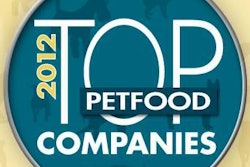
Five emerging supply chain trends are most important for petfood producers in 2012, according to Freightgate, developer of Internet and technology solutions for freight, logistics and distribution planning:
- More companies will explore vested outsourcing for supply chain and logistics requirements forming closer alliances with transportation software companies specializing in customizable cloud computing solutions. The increasing demand for better collaborative business processes, rate management and logistics procurement with greater execution capabilities is beyond the knowledge base, response time and budgets of most in-house IT departments.
- Dynamic customer engagement will become a high priority between shippers and transportation service providers. Seamless, time-sensitive information flow is rapidly becoming essential for everyone in the loop to be informed simultaneously and will create greater demand for event management, information visibility, collaborative what-if solutions and data security.
- The convergence of cloud, mobile and information technology into a unified set of forces is shaping IT decisions and marketplace competitiveness. More companies will adopt cloud computing and mobile applications within their supply chain and logistics processes. The trends for cloud computing and mobile applications are creating faster collaborative sharing of information top/down and bottom/up creating teamwork synergies improving processes, financial results and quicker solutions to customer requirements.
- Strategic transportation procurement is becoming a "board of directors decision." Transportation procurement is no longer only about freight rates and service parameters. The procurement footprint is quickly expanding to include carbon footprint, security compliance, reduction of non-core costs, acceleration of business value, collaborative cloud-based analytical platforms and more global environmental awareness.
- Response management drives demand for quicker, timely decision-making, rapid planning and predictive analytics to scenario responses of unplanned events. Logistics in an ever-changing environment combined with marketplace competitiveness can impact fiscal results in hours, not days. The goal of What-If scenarios is proactive anticipation instead of reaction. It equates to delivering the most timely knowledge and insights to ensure informed decision-making.
Keywords like collaboration, cloud computing and responsiveness will dominate the petfood supply chain landscape—is your company prepared? How will you ensure that a worry-free product is always being delivered safely, efficiently and in a timely manner to consumers? Let's examine products, technologies and companies who already have safe shipping solutions and innovative tracking methods in place.
The ability to trace just where the ingredients for a petfood product came from is something quite new in the consumer packaged goods industry. Until recently, this wasn’t something done for dog snacks, but now is thanks to new PetAg Inc.'s Rawhide Brand Essence Chews that carry special coded packaging with the date of production and ranch of origin for its chews. New in the US, this product has already been an innovation of the week from Datamonitor’s Product Launch Analytics.
Tom Vierhile, innovation insights director for Datamonitor, noted, “Food safety concerns have risen to the point where a few food companies are labeling products in such a way that consumers can find out where the ingredients came from. It is highly unusual to see the practice spread to pet snacks, such as this line of dog chews, and this could be a sign that this practice could really take off in 2012.”
Packagers looking for sustainable, safe production can reduce their corrugated use and ensure maximum product protection with display shippers that use up to 50% less corrugated than standard or wraparound cases with A-B-C Packaging's Model 206 packer, according to the company. 

The Model 206 packs cartons or bottles, single or multipacks into full height, half height or end-panel display trays at speeds to 30 trays per minute. Clear, interlocked panels offer high visibility and easy access during packing and shipping while providing total machine guarding, says A-B-C.
Material Discrimination X-ray (MDX) and SimulTask image analysis technologies from Eagle (formerly Smiths Detection Product Inspection) boost product inspection capabilities on petfood manufacturing lines through enhanced contaminant detection and ease of use, claims the company. The Eagle Tall PRO XS X-ray system uses SimulTask, while the Eagle Pack 430 PRO X-ray inspection systems uses both MDX and SimulTask technologies to allow petfood manufacturers to inspect products with complex density levels and in innovative pack styles with the high degree of reliability and flexibility required, says Eagle.
MDX technology enhances traditional X-ray inspection to allow detection of materials previously unseen by X-ray or other conventional inspection means. This allows detection and rejection of historically undetectable inorganic contaminants such as glass shards, rocks, rubber and plastic, according to the company. With SimulTask, managers can easily access statistics and reports on inspected products while its verification tools assist in compliance with hazard analysis critical control point (HACCP) guidelines and other regulations. Its full multi-lane and multi-view capability allows multiple products to be inspected at a time for efficiency benefits.
“Looking at the supermarket shelf, it is quite apparent that the consumer food landscape has changed and is continuing to change quite dramatically and rapidly. Gone are the days of producing one or two varieties of a single product in a neat, easy-to-inspect package,” says Terry Woolford, general manager of Eagle. “Advanced image analysis tools for X-ray inspection systems enable food manufacturers to make their wildest marketing and pack style ideas a commercial reality by enabling quality control to be performed at the levels required by regulatory bodies and consumers.”
















